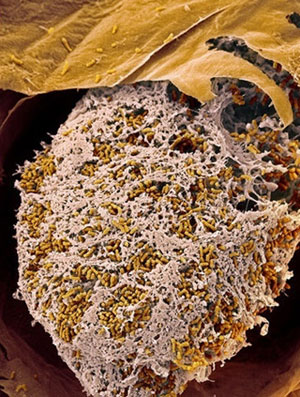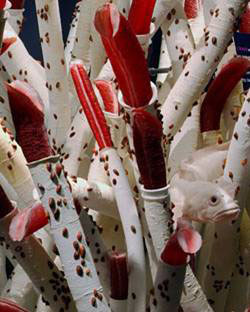Bacteria enter into mutually beneficial relationships with plants as well. For example, bacteria with nitrogen-binding properties live in the roots of clover and of peas. Any plant deprived of nitrogen will die sooner or later. For that reason, the bacteria living in nodules in the roots are so important. Why do these bacteria prefer peas? The reason lies in chemical communication among the two species. Symbiotic bacteria encourage the formation of small nodules in the roots by activating certain genes in the plant. The bacteria then use these nodules as shelters. In return, the plants acquire an endless supply of nitrogen.
 Nitrogen-fixing soil bacteria (Rhizobium sp.) living on a root nodule of a bean plant |
Another symbiotic relationship exists between the puffer fish and intestinal bacteria. Porcupine fish possess an unusual poison known as tetrodoxin, which is produced by the bacteria living in the fish's intestines. Although the greater part of this toxin is found in the liver, intestine and other internal organs, it spreads all through the fish's flesh. Some of it even enters the muscles. Anything that eats a porcupine fish is therefore exposed to a grave danger. Predators aware of this danger avoid eating it.45 In turn, this contribution from the bacteria prevents them from falling prey to other fish.
Of course, the poison that poses such a threat to other fish inflicts no harm on the porcupine fish itself, despite being spread throughout its entire body. This shows a flawless structure specially created by Allah for the fish's protection. That other fish are aware of the danger and try to avoid the porcupine fish, and that the bacteria have developed such a defensive weapon, show that Allah created these two species to be compatible with one another, is an example of His superior Creation.
Bacteria also enjoy an interesting relationship with tube worms, a single gram of whose inner tissues can contain 100 billion bacteria. The red hairs of tube worms are filled with blood carrying not oxygen, but hydrogen sulfate for the bacteria to feed on. In return, the bacteria oxidize the hydrogen sulfate, and turn the resulting carbon dioxide into carbon compounds that nourish the worms.46 The relationship between the two is based on an ex change of nourishment: While the worm feeds the bacteria, the bacteria produce food for the worm.
Another marine worm, Riftia pachyptila, needs bacteria for digestion. This species of worm has no digestive system of its own.
It used to be thought that this invertebrate lacking a digestive system absorbed organic substances dissolved in sea water by means of its skin. However, it was soon realized that the surface area of its skin is too small in proportion to its volume for it to possibly feed in this way. In 1981 the astonishing discovery was made that the worm actually fed in a normal way, but that its digestion was actually performed by bacteria. The cooperation between the worm and the bacteria is indeed most practical. The water the worm takes in through its gills is rich in sulfur and oxygen, substances carried by its bloodstream to where the bacteria can make organic compounds. The waste materials of metabolisms such as substances containing nitrogen and carbon dioxide are reabsorbed by bacteria and turned into nutrients.
 Tube worms |
The worm's metabolic wastes, such as carbon dioxide and nitrogenous substances, are taken up by the bacteria and again turned into food. Under normal conditions the sulfurous hemoglobin resulting from these chemical processes should be unable to transport oxygen and should have a toxic effect on the worm's respiratory enzymes. Yet this problem has been resolved thanks to a special Creation: a protein in the worm's stomach that protects hemoglobin by binding to sulfur.
The empty space in the worm's body provides room for bacteria, the foodstuffs produced by the bacteria to nourish the worm, and the worm's waste products allow the bacteria to thrive. Meanwhile, the enzyme produced as a result of these processes prevents the worm from being poisoned.
The many-faceted cause-and-effect relationship manifested in this small example of symbiosis points to a single fact that Allah reveals in a verse:
Everything in the heavens and Earth belongs to Allah. Allah is the Rich Beyond Need, the Praiseworthy. If all the trees on Earth were pens and all the sea, with seven more seas besides, was ink Allah's words still would not run dry. Allah is Almighty, All-Wise. (Surah Luqman, 26-27)


